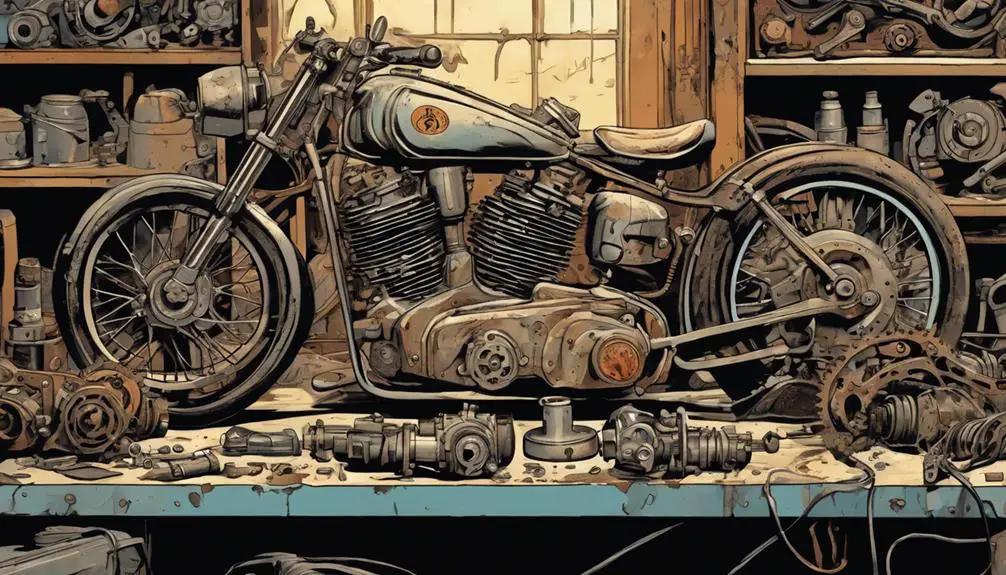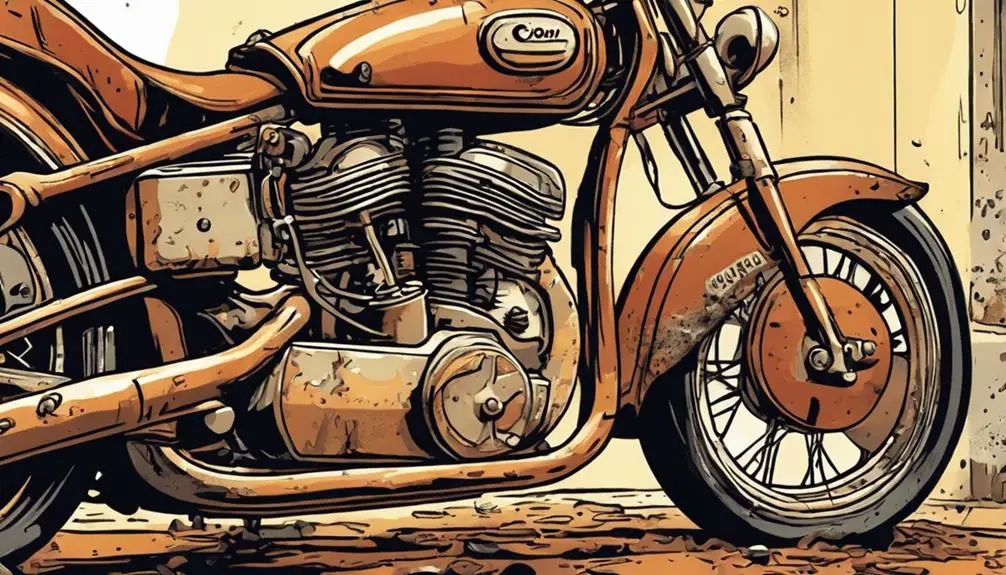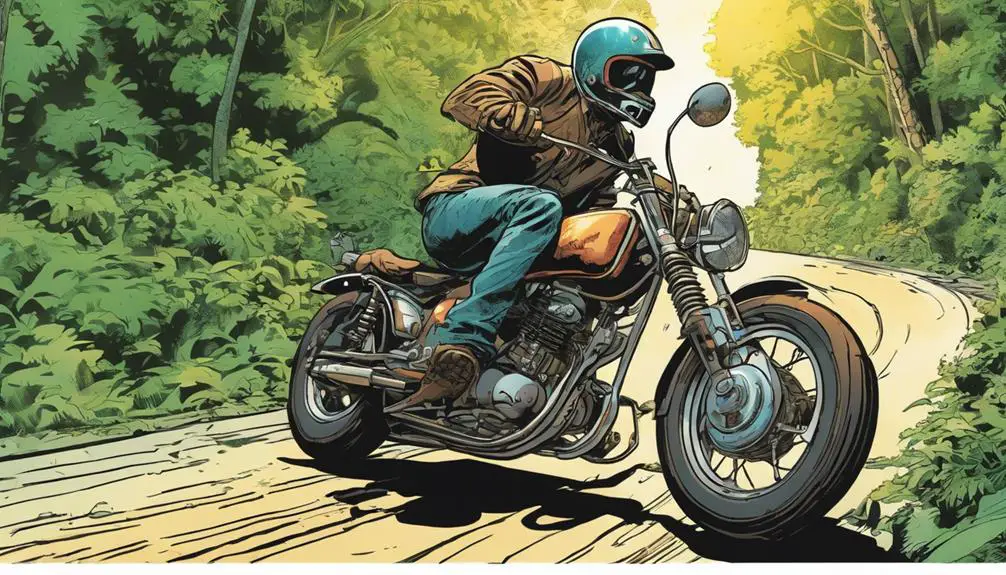When you own a vintage motorcycle, you'll quickly encounter some common issues that can impact your ride. Engine reliability is often a top concern, along with outdated electrical systems that can leave you stranded. Fuel system problems, brake performance, and even suspension challenges add to the list of considerations for any enthusiast. Understanding these key issues is vital for maintaining your bike's performance and safety. But how do these problems specifically affect your riding experience, and what can you do about them? Let's explore the details.
Quick Takeaways
- Engine Reliability: Older engines may experience breakdowns due to compression issues, oil leaks, and the need for regular maintenance checks on gaskets and seals.
- Electrical System Failures: Vintage motorcycles often suffer from faulty wiring and corrosion, necessitating regular inspections to maintain reliable performance.
- Fuel System Issues: Clogged fuel lines and carburetor problems can significantly hinder engine performance, requiring cleaning or rebuilding for optimal function.
- Brake Performance Problems: Worn brake pads and contaminated fluid can compromise stopping power, highlighting the need for regular fluid replacement and inspection.
Engine Reliability Concerns

When it comes to vintage motorcycles, you'll often find that engine reliability is a major concern for many enthusiasts. You crave the freedom of the open road, but a faltering engine can quickly shatter that dream. Older engines, while charming, often come with quirks that can lead to unexpected breakdowns. You should pay attention to factors like compression levels, oil leaks, and valve adjustments.
Regular maintenance is key to keeping your vintage ride reliable. You'll want to check the condition of gaskets and seals, as these often wear down over time. It's also wise to inspect the carburetors and fuel lines, ensuring a steady flow of fuel to that classic engine.
Don't underestimate the importance of a proper tune-up. A well-tuned engine won't only perform better but will also give you the confidence to take on longer journeys without fear. You're not just maintaining a machine; you're nurturing a piece of history.
Electrical System Failures
While engine reliability is vital, electrical system failures can also derail your vintage motorcycle adventures.
Imagine cruising down an open road, feeling the wind in your hair, only to have your bike suddenly lose power. Frustrating, right? Vintage motorcycles often come with outdated electrical systems that can lead to a range of issues, from faulty wiring to weak batteries.
You'll want to keep an eye on connections, as corrosion can creep in and ruin your ride. Inspect the wiring harness regularly; brittle wires can break, leaving you stranded.
Pay attention to your battery, too. Vintage models may require frequent replacements to guarantee you've got the spark needed for smooth starts.
Don't forget about the charging system. A malfunctioning generator or regulator can cause your battery to drain, forcing you to play mechanic instead of enjoying the freedom of the road.
Equip yourself with some basic electrical knowledge, and consider upgrading components for better reliability.
Ultimately, staying proactive about your vintage bike's electrical system can keep the spirit of adventure alive, letting you ride freely without the fear of sudden failures. Embrace the journey, and keep the thrill of the ride alive!
Fuel System Issues

Fuel system issues can seriously dampen your riding experience, leaving you frustrated when your vintage motorcycle struggles to stay fueled and responsive. One of the most common culprits is a clogged fuel line or filter, which can restrict the flow of gas to your engine.
You might also encounter problems with the carburetor, such as stuck floats or dirty jets, affecting performance. Don't ignore the fuel quality either; old gas can go stale and lead to engine troubles. Regularly check your tank for sediment or rust, which can wreak havoc on your fuel system.
If your bike's not starting or idling poorly, it's time to explore the fuel system. Cleaning or rebuilding the carburetor might be necessary, and replacing old fuel lines can restore your ride's freedom.
Take charge of your vintage motorcycle's fuel system—don't let it hold you back. By addressing these issues, you'll reclaim the exhilarating liberation of the open road. Your bike deserves to run smoothly, and you deserve the wind in your hair without the hassle of fuel problems.
Stay proactive, and keep your vintage machine performing at its best!
Brake Performance Problems
After tackling fuel system issues, it's time to focus on brake performance problems that can compromise your safety and riding enjoyment. If you're riding a vintage motorcycle, you might face challenges like worn brake pads, leaky brake lines, or outdated systems that struggle with modern demands. Don't ignore these issues; they can seriously affect your ability to stop effectively.
Start by inspecting your brake pads. If they're worn down, replace them to guarantee maximum grip.
Next, check the brake fluid. Old or contaminated fluid can lead to spongy brakes, making it harder to stop on a dime. Consider flushing your brake lines and replacing the fluid to restore responsiveness.
Also, examine your brake calipers and master cylinder. If you notice fluid leaks or any corrosion, it's essential to address these problems.
Upgrading to modern components can enhance your braking system's reliability and performance, giving you the freedom to ride with confidence.
Suspension and Handling Challenges

Suspension and handling issues can greatly impact your riding experience, making it essential to address them promptly on your vintage motorcycle.
An outdated or worn suspension system can lead to a bumpy ride, diminishing your sense of freedom on the open road. You might feel every bump, pothole, and imperfection, robbing you of the smooth, liberating journey you crave.
Check your shocks and forks for leaks, wear, or damage. If they're not functioning well, they can affect your bike's stability and cornering ability. You want to glide through turns, not wrestle with your motorcycle. Replacing old components with modern alternatives can enhance your ride and give you that exhilarating feeling of control.
Don't overlook tire pressure and condition, either. Improperly inflated or worn tires can exacerbate handling problems, making your vintage bike more difficult to manage. Regularly inspect your tires for cracks or uneven wear.
Common Questions
What Are Common Cosmetic Issues in Vintage Motorcycle Models?
When you immerse yourself in vintage motorcycles, you'll notice common cosmetic issues that can affect their charm.
You might find rust on the chrome, faded paint, or worn-out leather seats. Scratches and dents often tell stories of past rides, while aging decals can peel away.
It's essential to inspect these details, as they can impact both the bike's appearance and its value. Restoring them can breathe new life into your ride, enhancing its freedom and character.
How Do I Find Replacement Parts for Vintage Motorcycles?
Finding replacement parts for vintage motorcycles can feel like chasing a ghost through a foggy forest.
Don't worry, though; you're not alone.
Start by scouring online forums and marketplaces where fellow enthusiasts gather, sharing leads and tips.
Local motorcycle shops often have hidden gems, too.
If you hit a dead end, consider reaching out to specialty retailers or salvage yards—they might just have what you need to revive your ride.
Are Vintage Motorcycles Suitable for Daily Riding?
Are vintage motorcycles suitable for daily riding? Absolutely!
Riding a vintage bike offers a unique sense of freedom, connecting you to the spirit of the road. While they may require more maintenance than modern bikes, the joy and character they bring can't be matched.
Just be prepared for potential quirks and make sure you've got reliable parts and tools handy. Embrace the adventure and let the wind guide you on your daily journeys!
What Maintenance Should I Perform on a Vintage Motorcycle?
You might think maintaining a vintage motorcycle is overwhelming, but it doesn't have to be!
Start by regularly checking the oil and changing it as needed.
Inspect the tires for wear and keep them properly inflated.
Don't forget to clean and adjust the chain frequently.
Finally, check the brakes and electrical system to guarantee everything's functioning smoothly.
With a bit of effort, you'll experience the freedom of riding your classic bike worry-free!
How Can I Increase the Resale Value of My Vintage Motorcycle?
To increase your vintage motorcycle's resale value, focus on restoration and maintenance.
Keep it clean and well-documented; potential buyers love seeing a history of care.
Upgrade parts only if they enhance value, and retain original components when possible.
Consider investing in quality aftermarket accessories that appeal to enthusiasts.
Finally, showcase your bike at local events or online communities to attract passionate buyers.
Your bike's story and presentation can make a big difference!
Wrapping Up
So, as you immerse yourself in the world of vintage motorcycles, keep an eye out for those lurking issues.
Will your engine hold up under pressure, or will the electrical gremlins strike?
Fuel system quirks could catch you off guard, and don't forget about the brakes—can you trust them on that twisty road?
And what about the ride itself? With every turn, the thrill of the unknown beckons.
Stay vigilant, and your vintage adventure could be truly unforgettable.